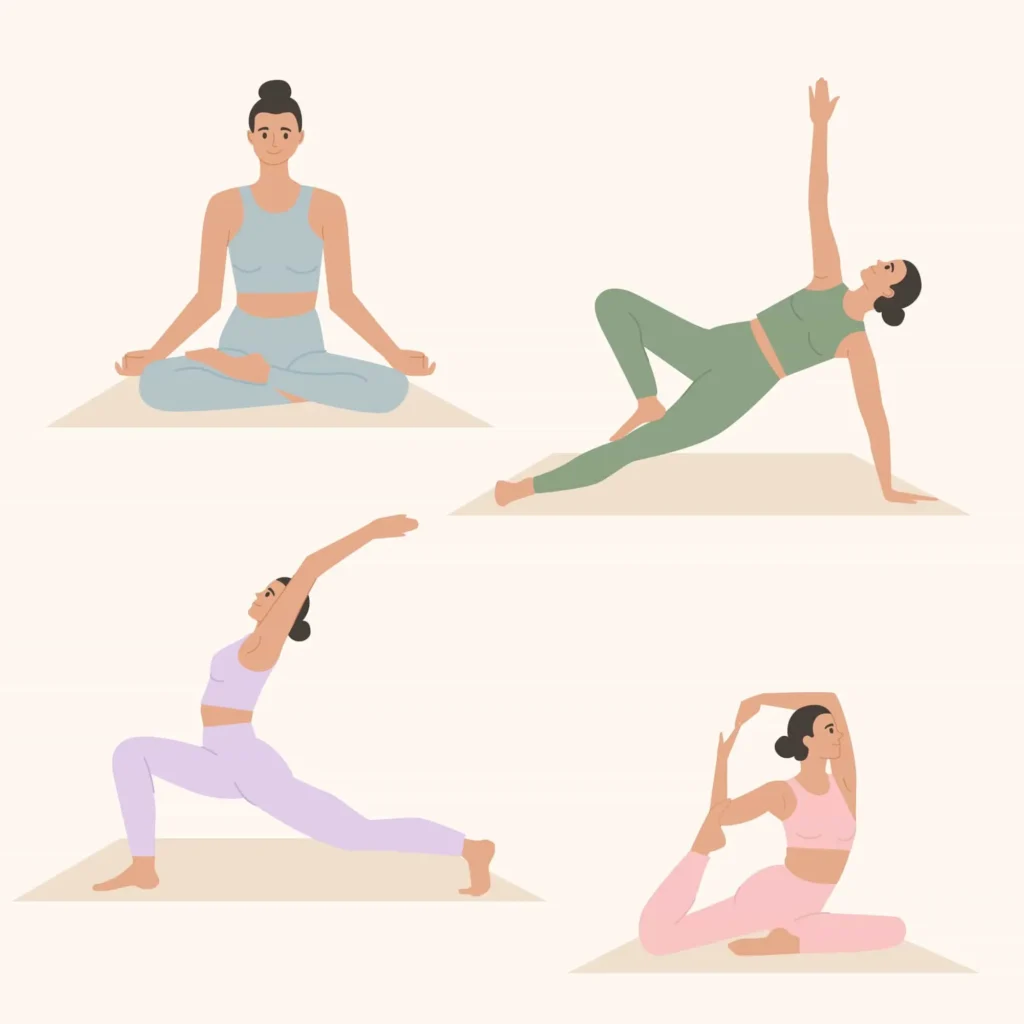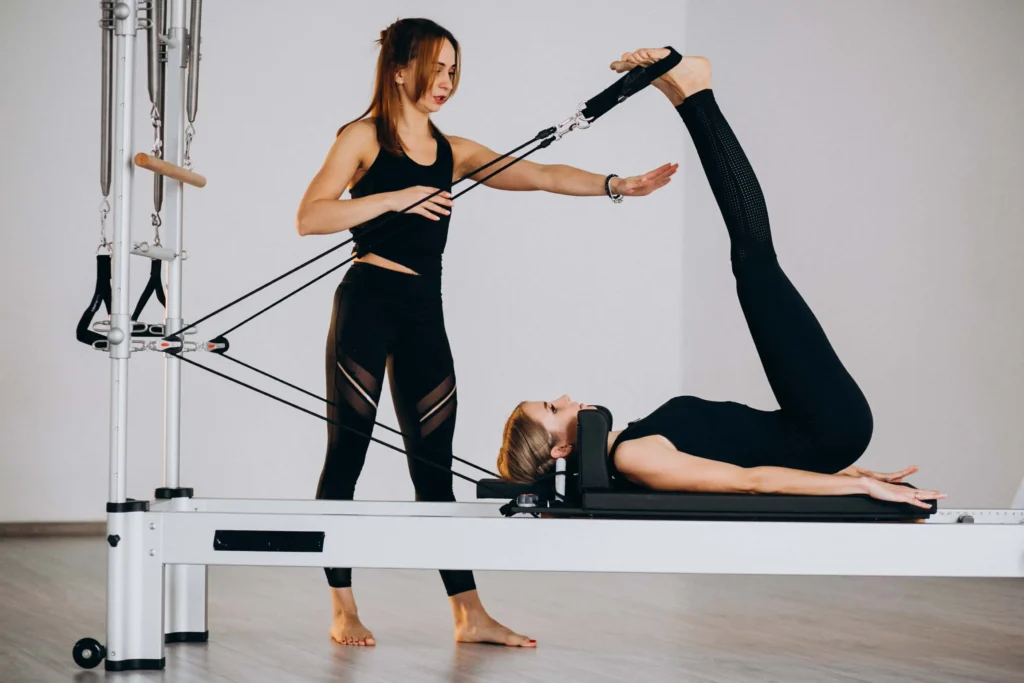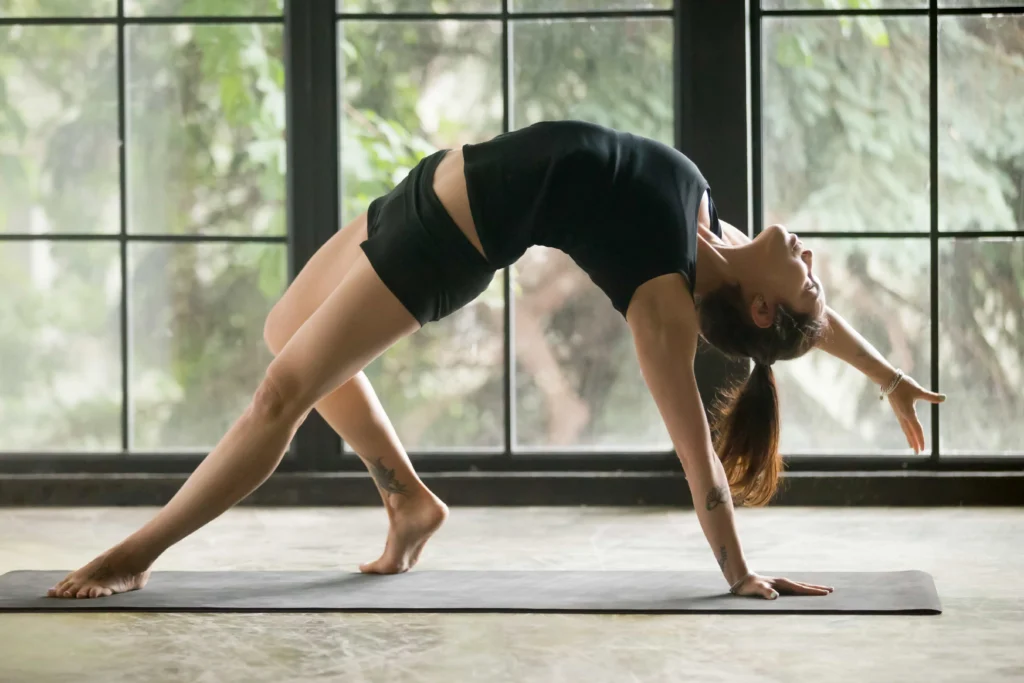In present times, fitness programs such as Yoga and Pilates have experienced a rapid spread and are universally popular. Yet, knowledge of their dissimilarities will help in the exercise method that is well suited for a person’s health journey. This guide will go through Yoga vs Pilates, introducing every aspect such as basics, benefits, differences, and how to start your workout journey:
Introduction to Yoga vs Pilates
So many of us frustratedly repeat the same question, “What are the main differences between Pilates and yoga?” Sharing some commonalities, Pilates and yoga are markedly different in the way they were founded, the techniques they apply, and the goals they pursue. In the course of this guide, we will take a close look at each training method, the differences in exercises and how they can support your fitness goals.
What is Yoga?
Yoga is a thousand-year-old ancient exercise that was born in India more than 5,000 years ago. It is centered on establishing a mind-and-body link that is accomplished through the practice of various postures (asanas), as well as breathing (pranayama) and meditation exercises. Yoga is often taken as an integrative approach to health and aims to improve physical, mental, and spiritual health.
Types of Yoga and How to Practice
Yoga is a vibrant ecosystem and offers for different needs and fitness levels different styles:
- Hatha Yoga: A great start for beginners, concentrating on simple poses and relieving the muscles.
- Vinyasa Yoga: A fun, dynamic, and flexible exercise wherein the movements flow naturally with the breath for a cardiovascular-type workout.
- Yin Yoga: Exercise slowly guided, that extends the muscles during the time, thus relaxes the body.
For those interested in flexibility, Be More Flexible with Yoga – A Step-By-Step Guide to Poses and Benefits is a resource that would guide you through the yoga exercises that positively affect flexibility and correct the structure of the body to our site.

Benefits of Yoga
Yoga brings not only physical but also mental, and spiritual advantages. Here are the key ones:
- Enhanced Flexibility: A regular yoga practitioner becomes more flexible by their practice, which helps them prevent injuries.
- Improves Sleep Quality: Research has found that yoga’s breathing, meditation, and physical practices are very effective in fostering sleep, especially in those with sleep disorders. For those who continue to face problems with sleep after yoga, the Ultimate Guide to Better Sleep is a wealth of practical tips.
- Reduces Stress: Yoga can assist stress-relief by the practice of yoga, and meditation on the present moment. The mindfulness and meditation of yoga are well known in the yoga world and are established to be helpful stress reduction and mental clarity big time.
What is Pilates?
Pilates is an alternative approach to exercise programs designed by Joseph Pilates in the early 20th century. He initially invented Pilates to facilitate physical rehabilitation, and it has since become a popular method of overall physical conditioning, concentrating on core strength, balance, and posture.
Pilates Exercises and Techniques
The basic Pilates exercises are usually of two kinds:
- Mat Pilates: it is that type of Pilates that uses only one’s own body weight as a resistance to develop good balance and core strength.
- Reformer Pilates: It is performed by using a special apparatus called a reformer, which uses springs and pulleys for resistance.
Both Pilates mat and reformed-invested in Pilates are used as an outlet for building the body’s alignment, and the title of Pilates techniques is: Muscle toning and body alignment through mat/reformer exercises.

Benefits of Pilates
Pilates on its own is a versatile workout and can serve various fitness levels and different goals:
- Strengthens the Core: Pilates, exercise for the core allows for core stabilization that is necessary for maintaining proper posture and avoiding back pain?
- Improves Muscle Tone and Endurance: Pilates is known for the flexibility of controlled movements, promotes muscle toning and endurance building.
- Limited flexibility: Bending and stretching exercises develop the flexibility to support the cardio routines of various types. If you are looking for cardio exercises that you can do at home, Cardio Exercises at Home: Your Ultimate Guide to Boosting Fitness can give you some routine options that can be done even at home.
Yoga vs Pilates for Weight Loss
The difference between Pilates and yoga as options to lose weight is that both can be good, but it depends on the style and intensity of them. Yoga, especially Vinyasa or Ashtanga, so many not only increase flexibility but also can serve as a powerful cardi workout by consuming calories. Pilates, with its emphasis on core stability, can also be that, specifically in strength workouts of the muscles, you will also tend to tone, and the different body parts involved will be more defined.
Lose Belly Fat Without Supplements: Our Top Natural Methods talks about using ways to lose weight without supplements that are tried and tested and help to eliminate body fat. Thus, if you want to learn the natural ways for weight loss and aren’t willing to try supplements, go to our Lose Belly Fat Without Supplements: Top Natural Methods blog post where we describe the very effective ways to lose fat.

Which is Better for You: Yoga vs Pilates
According to your goals, Pilates or yoga would be the best.
If all you expect is limberness and peace of mind: Yoga could be the Perfect solution for people who are interested in mental health in addition to physical fitness. A flexible leisure time can be a great opportunity for sports, and also for natural breathing and body stretching. Pilates and yoga are instruments for physical health as well as mental well-being.If your target is drawn at your core muscles and muscle tone: Pilates undeniably raises your core endurance and fitness as well as enhancing your body tone.
Besides strengthening and yoga, both Pilates and yoga, which can be combined for a multifaceted fitness agenda, are effective for an even distribution of power and flexibility throughout the body.
Integrating Pilates or Yoga into Your Fitness Routine
By attending either Pilates or yoga along with your physical activity schedule, you will have a well-rounded workout, for instance, it can facilitate functional strength in Pilates training along with resistance exercises such as Tai Chi, Calisthenics, and others. Our article How Resistance Bands Can Enhance Your Fitness Routine: Expert Advice provides tips on using bands for added resistance in any workout.
Yoga is also a good addition to endurance exercises, such as HIIT and cardio where yoga sessions can help with muscle recovery. Check out HIIT Workouts at Home: The Best Equipment and Exercises where you can find sufficient, equipment-based exercises.
Expert Opinions on Yoga vs Pilates
Health specialists recognize the psychological and physical benefits of yoga vs pilates. “Although yoga and Pilates are different, they rely on each other’s strengths to achieve multiple fitness objectives. Therefore, it is a matter of taste and needs”, Dr. Sarah Smith, a part of the Harvard research team, believes. By quoting the American Council on Exercise, which is regarded as a credible figure in the field of exercise, one can clearly illustrate the methodology of mixing and matching these disciplines that lead to maximum benefits.

Final Thoughts on Yoga vs Pilates
When one needs to make a choice between Pilates and yoga, there is actually no clear-cut “better” option. They both have their own unique advantages that can be used to help different health goals. Whether you’re looking for yoga to improve your flexibility as explored in our article Improve Your Flexibility with Yoga or Pilates to build your core, the correct exercise is one that follows your wellness objectives.
Thus, by adding either or both of these practices in your routine, you will do fitness from a holistic perspective. Through such a process, you will notice not only physical strength and flexibility improvements but also mental clarity and stress management.
FAQ’s
What are Pilates exercises?
Pilates are traditional low-intensity workouts that emphasize the core and aimed at good flexibility, balance, and limb alignment, made by Joseph Pilates to develop muscle control and body awareness.
What are wall Pilates exercises?
Wall Pilates make use of the wall for stability and alignment building thus improve the ab action and the entire body control.
What Pilates exercises should be avoided during pregnancy?
Doing Pilates exercises such as deep abdominal exercises and twisting movements are best to be avoided during pregnancy, as laying on your back for some exercises may create unwanted damage to your body and cause potential dangers.
What Pilates exercises should be avoided with scoliosis?
While Pilates exercises for scoliosis are avoidance anxiety, the most crucial factor that must be followed is the avoidance of exercises that are very tough for the spine to twist, deep back bends, and side-bending movements that may cause problems for the spinal alignment.
What is Yoga vs Pilates?
Like all good exercises, Pilates and yoga are also unique in their purposes and techniques. Yoga is a primitive exercise that involves physical asanas, breathing exercises, pranayama, and meditation. It aims at flexibility, mindfulness, and spiritual growth. Pilates was born in the 19th century thanks to Joseph Pilates, it consists of core strength, and body stabilization along with alignment. While yoga connects the mind and the body with its core method being peace of mind, Pilates is a form of aerobic exercise that concentrates mainly on controlled movements and physical endurance. They both, however, contribute to the other factor, the improvement of the physical part and the mental.
Yoga vs Pilates: Which is Better?
The choice of which to go with, be it yoga or Pilates, is guided by the personal aspirations and interests of an individual. Using yoga is to be more flexible, release stress, and practice mindfulness. It provides a balanced physical and mental health method and has various forms that run from soft to difficult. In comparison, Pilates is suitable for those who, through exercises, target the core, aim at toning the muscles, and work on posture improvement. For most individuals, a mix of both practices can help them get a full fitness routine that not only develops the body but also makes them focused.
What are the Benefits of Yoga vs Pilates?
In their separate ways Pilates and yoga have a great deal of positive impact:
Yoga Benefits: Yoga Sparks Flexibility, Mindfulness, Satisfaction, Mental Clarity, Muscle Building, and the Feel of a Sense of Inner Peace. Among the yoga types, there are those like Hatha, Vinyasa, and Yin which have different degrees of intensity and relaxation.
Pilates Benefits: It is a program that targets the core of your body, thus it strengthens the muscles and makes the correct posture. It also prolongs your muscle endurance and is an ideal rehab method after an injury has occurred. Pilates additionally provides the balance of muscle and physical alignment which in return makes it the best option for body fitness.
Yoga vs Pilates for Back Pain
Both, yoga and Pilates are one of the best “drugs” that relieve back pain but they work both in a different way. Pilates is an excellent method of treatment for back pain because it combines the principles of core strength and spinal alignment which together help support the back and lessen the already existing tension. Yoga, in turn, is helpful in back pain relief due to mild stretching and flexibility exercises that especially help the spine to extend and go more relaxed. Additionally, the more restorative yoga styles such as Yin Yoga, relaxation yoga, or bodywork, are also appropriate for those who suffer from long-term back issues.
Yoga vs Pilates for Toning
Even though Pilates has the upper hand over yoga in terms of muscle toning, since it offers exercises that are specific to core workouts, as well as ones that apply gravity or bands, it also involves various isotonic movements that show alternative paths for muscle activation. Yoga, incidentally, shapes the muscles too, through weight holding poses such as Plank and Warrior, which are the primary ones that help build the upper and lower bodies. Doing both is tantamount to creating a balanced toning plan that traverses the entire body.
What is Yin Yoga?
Yin Yoga is a kind of long-lasting slow yoga practice that relies on keeping the body poses for several minutes, so deep connective tissues are stretched not the muscle, the connective tissue namely ligaments, joints, or fascia. It is flexibility and joint motion, while also decreasing the activation of body muscles and calming the mind, that this pose promotes. Yin Yoga is the style of yoga that has a calming effect and helps dissolve the body of accumulated tension. As a result, it becomes a practice of mind and body which has a therapeutic value.
What is Hatha Yoga?
Hatha Yoga can be described as a foundation for all other yoga methods seeing as it uses physical postures as primary and has a focus on alignment and breath control as the main technique. Often, it is slower-paced and thus becomes a very suitable method for beginners. Hatha yoga classes that are focused on the type of styles will incorporate simple poses and breath work amidst others, and will therefore serve as a gateway for advanced yoga practices.
What is Vinyasa Yoga?
Vinyasa Yoga is a yoga practice style based on movement that synchronizes the breathing pattern and sequence of the poses. The distinctive feature of Vinyasa is its flowing postures which are further reinforced with a cardio-like intensity helping to develop muscle endurance, flexibility, and boost resilience. It’s perfect for individuals who prefer a rigorous practice and are striving to improve both physical health and mental concentration.

